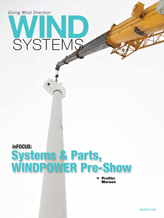ExxonMobil’s Mobil SHC Gear 320 WT is the first industrial lubricant to receive the DNV GL conformity statement. Gary Hennigan, wind lubricants technical adviser with ExxonMobil, discusses what that means.
What do you do with ExxonMobil?
I’ve been with ExxonMobil for 20 years and have supported the wind industry for more than a decade. In my current role, I oversee the wind energy portfolio — specifically supporting wind operators manage their lubrication programs.
Tell us about the DNV GL statement of conformity.
DNV GL is one of the world’s leading quality assurance and risk management companies, providing classification, technical assurance, software, and independent expert advisory services to the renewable energy industry, among others. Receiving this conformity statement means that DNV GL has independently assessed the performance characteristics of Mobil SHC Gear 320 WT gear oil and confirmed that it meets the global IEC 61400-4 standard. This is a landmark international standard that identifies test criteria to ensure reliability for wind-turbine gearboxes.
Receiving this statement supports our claims that the technology behind Mobil SHC Gear 320 WT gear oil is best-in-class and is capable of supporting equipment reliability for the short, medium and long-term.
When you have the engineering team of a third-party organization confirm the performance of your technology, it’s something that gives owner-operators and investors peace of mind knowing that our technology is reliable and can truly help protect their equipment for the long haul.
How important is the conformity statement from an operator’s perspective?
I think it validates ExxonMobil’s belief in terms of the quality of this gear-oil technology, especially since we’re the first lubricant manufacturer to receive this statement of conformity. I think the industry would recognize and appreciate it, but to me, it underscores our technology leadership and ExxonMobil’s commitment to providing our customers with products they can count on.
What is the role of the lubricant in protecting wind-turbine equipment?
Wind turbines are exposed to some of the harshest operating conditions in the industrial world — extreme temperatures, heavy loads, strong winds, water exposure, just to name a few. Given these conditions, lubrication is often the first line of defense when it comes to making sure that your equipment keeps running as needed.
But not all lubricants are the same. The lubricant needs to be formulated to meet the needs of the job at hand. For example, wind-turbine gearboxes require an oil formulation thick enough to prevent metal-to-metal contact at lower rotations and higher loads, but thin enough to flow when turbines reach full speed.
Mobil SHC Gear 320 WT synthetic gear oil was developed using a balanced formulation approach, meaning it has the right mix of advanced base oils and additive technologies to perform as needed in the harsh and severe conditions common to most wind-turbine operating environments.
What makes this lubricant stand out compared to competitive products?
The biggest performance benefit — and differentiating benefit — is its long life. Most gear oil changes today happen within a three- to five-year period, depending on the OEM and the turbine conditions. The technology behind Mobil SHC Gear 320 WT guarantees the oil to last at least seven years, meaning operators can go years longer without conducting an oil change. Over the 20-year life of a turbine, that longer oil life could help eliminate one entire oil change. We back this performance up with a seven-year warranty on the product.
Another benefit of this product is that it is proven to not contribute to a leading cause of bearing failure in a gear box — white etching cracking (WEC). Working with leading bearing manufacturer Schaeffler, we were able to confirm that Mobil SHC Gear 320 WT gear oil does not contribute to WEC thanks to its metal-free formulation. There are a number of factors and bad actors that can contribute to WEC in a bearing, but the “a-ha” insight is that Mobil SHC Gear 320 WT does not. It is one more reason to choose this oil.
Our ability to engineer and manufacture such a high performing oil is a result of ExxonMobil’s investments in technology, research, and development, as well as the 20-year plus legacy of our equipment builder group. Our equipment builder group works closely with OEMs around the world to develop lubrication solutions tailored specifically to meet the needs of their most advanced equipment. So, for example, when the wind industry first started looking at issues of how bearings were failing early, these relationships helped us become one of first companies to introduce a synthetic gear oil.
With the PTC phase out on the horizon, how will lubrication factor into operators’ decision-making moving forward?
We’re entering a new period in the industry where operators are expected to do more with less. Once the PTC phases down, there will be increased pressure to keep O&M costs as low as possible, since most operators will have less upfront capital to finance projects. For example, according to the Energy Information Administration, the levelized cost of energy (LCOE) is expected to increase by approximately 30 percent from 2019 to 2022 while fixed O&M costs will remain about the same.
At the same time, many operations will have turbines that are entering a post-warranty period, so the responsibility and burden of keeping those turbines running will fall on the operators themselves. The stakes are higher.
How can operators get the most out of their maintenance budget to help keep turbines running and costs down over the long term?
To do this, wind operators should make smart investments in their operations and maintenance programs.
That includes investing in a robust lubrication program built around advanced lubricant technologies and services such as routine used oil analysis. As the performance of Mobil SHC Gear 320 WT gear oil indicates, using high quality oils can be a difference maker as long-term O&M costs can be better managed. The less often you conduct an oil change, the more you save.
This is particularly true for gearboxes, which are still one of the primary bad actors in unplanned downtime situations. If I’m an owner-operator, or if I’m an OEM provider or service provider, I’d want to focus my efforts on making sure the gearbox is properly protected so that turbines are running with as much availability as possible.
For more information, go to www.mobil.com/industrial








































